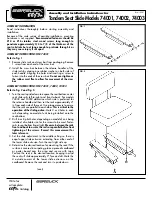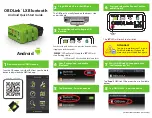
The SR Series have
amazingly high headroom.
Like the 8•Bus and the
CR-1604 before them, their
bus and main mix amplifi-
ers use Mackie’s distinctive
negative gain mix amplifier
architecture, for up to twice
as much extra headroom.
Since the mix amp is where
all the signals come
together, we built ours to
deal with lots of hot signals
and still supply astonishing
headroom and low noise.
VLZ — Very Low Imped-
ance — is another reason
that the SR24•4 and 32•4
are such low-noise mar-
vels. VLZ architecture
means minuscule noise
levels in both live and
recording situations. Ther-
mal noise is created in
every bit of circuitry inside
a console; Mackie’s VLZ
design reduces thermal
noise by making internal
console impedances as
low as possible, in as
many places as possible.
In the live arena, the
sound in the mains will
be as quiet as a church
mouse (when there’s no
other sound coming
through). And in record-
ing, VLZ’s low noise will
garner pristine tracks on
analog tape, digital tape,
hard disk — whatever the
medium, the SR Series con-
soles are incredibly quiet.
VLZ
VERY LOW IMPEDANCE DESIGN
dB
30
20
10
O
O
40
50
5
5
U
60
10
dB
30
20
10
O
O
40
50
5
5
U
60
10
dB
30
20
10
O
O
40
50
5
5
U
60
10
dB
30
20
10
O
O
40
50
5
5
U
60
10
dB
30
20
10
O
O
40
50
5
5
U
60
10
dB
30
20
10
O
O
40
50
5
5
U
60
10
dB
30
20
10
O
O
40
50
5
5
U
60
10
dB
30
20
10
O
O
40
50
5
5
U
60
10
dB
30
20
10
O
O
40
50
5
5
U
60
10
MI
C GAIN
10
U
60
+10dB -40dB
-10
L
R
L
R
L
R
L
R
L
R
L
R
L
R
L
R
L
U
O
O
+15
U
O
O
+15
U
O
O
+15
U
O
O
+15
U
+15
-15
U
+15
-15
8kHz
100
U
+15
-15
U
O
O
+15
U
O
O
+15
MI
C GAIN
10
U
60
+10dB -40dB
-10
MI
C GAIN
10
U
60
+10dB -40dB
-10
MI
C GAIN
10
U
60
+10dB -40dB
-10
MI
C GAIN
10
U
60
+10dB -40dB
-10
MI
C GAIN
10
U
60
+10dB -40dB
-10
MI
C GAIN
10
U
60
+10dB -40dB
-10
MI
C GAIN
10
U
60
+10dB -40dB
-10
MI
C GA
10
U
+10dB -
U
O
O
+15
U
O
O
+15
U
O
O
+15
U
O
O
+15
U
+15
-15
U
+15
-15
U
+15
-15
U
O
O
+15
U
O
O
+15
U
O
O
+15
U
O
O
+15
U
O
O
+15
U
O
O
+15
U
+15
-15
U
+15
-15
U
+15
-15
U
O
O
+15
U
O
O
+15
U
O
O
+15
U
O
O
+15
U
O
O
+15
U
O
O
+15
U
+15
-15
U
+15
-15
U
+15
-15
U
O
O
+15
U
O
O
+15
U
O
O
+15
U
O
O
+15
U
O
O
+15
U
O
O
+15
U
+15
-15
U
+15
-15
U
+15
-15
U
O
O
+15
U
O
O
+15
U
O
O
+15
U
O
O
+15
U
O
O
+15
U
O
O
+15
U
+15
-15
U
+15
-15
U
+15
-15
U
O
O
+15
U
O
O
+15
U
O
O
+15
U
O
O
+15
U
O
O
+15
U
O
O
+15
U
+15
-15
U
+15
-15
U
+15
-15
U
O
O
+15
U
O
O
+15
U
O
O
+15
U
O
O
+15
U
O
O
+15
U
O
O
+15
U
+15
-15
U
+15
-15
U
+15
-15
U
O
O
+15
U
O
O
+15
U
O
O
U
O
O
U
O
O
U
O
O
U
-15
U
-15
U
-15
U
O
O
U
O
O
8kHz
100
8kHz
100
8kHz
100
8kHz
100
8kHz
100
8kHz
100
8kHz
100
8
100
-20
OL
PRE
1
PRE
PRE
2
3
5
6
12k
HI
MID
FREQ
80Hz
LOW CUT
75 Hz
18dB/OCT
LOW CUT
75 Hz
18dB/OCT
LOW CUT
75 Hz
18dB/OCT
LOW CUT
75 Hz
18dB/OCT
LOW CUT
75 Hz
18dB/OCT
LOW CUT
75 Hz
18dB/OCT
LOW CUT
75 Hz
18dB/OCT
LOW CUT
75 Hz
18dB/OCT
LOW C
75 H
18dB/O
LOW
80Hz
LOW
80Hz
LOW
80Hz
LOW
80Hz
LOW
80Hz
LOW
80Hz
LOW
80Hz
LOW
TRIM
1
AUX
1
MUTE
EQ
3-4
L-R
1-2
3-4
L-R
1-2
3-4
L-R
1-2
3-4
L-R
1-2
3-4
L-R
1-2
3-4
L-R
1-2
3-4
L-R
1-2
3-4
L-R
1-2
-20
OL
PRE
1
PRE
PRE
2
3
5
6
12k
HI
MID
FREQ
TRIM
2
AUX
2
MUTE
EQ
-20
OL
PRE
1
PRE
PRE
2
3
5
6
12k
HI
MID
FREQ
TRIM
3
AUX
3
MUTE
EQ
-20
OL
PRE
1
PRE
PRE
2
3
5
6
12k
HI
MID
FREQ
TRIM
4
AUX
4
MUTE
EQ
-20
OL
PRE
1
PRE
PRE
2
3
5
6
12k
HI
MID
FREQ
TRIM
5
AUX
5
MUTE
EQ
-20
OL
PRE
1
PRE
PRE
2
3
5
6
12k
HI
MID
FREQ
TRIM
6
AUX
6
MUTE
EQ
-20
OL
PRE
1
PRE
PRE
2
3
5
6
12k
HI
MID
FREQ
TRIM
7
AUX
7
MUTE
EQ
-20
OL
PRE
1
PRE
PRE
2
3
5
6
12k
HI
MID
FREQ
TRIM
8
AUX
8
MUTE
EQ
9
MUT
SOLO
SOLO
MUTE / SOLO
MUTE / SOLO
MUTE / SOLO
MUTE / SOLO
MUTE / SOLO
MUTE / SOLO
MUTE / SOLO
MUTE / SOLO
MU
SOLO
SOLO
SOLO
SOLO
SOLO
SOLO
PAN
PAN
PAN
PAN
PAN
PAN
PAN
PAN
PAN
4
4
4
4
4
4
4
4
Recording flexibility.
Because the SR Series’
buses are “double-bussed,”
outputs to an 8-track re-
corder (like ADAT or
DA-88) are a snap and can
be achieved without
repatching. Plus, the
Phones/Control Room
switch and level control is
connected to two stereo
phone outputs and the
Control Room output, let-
ting you route the stereo
Tape Return to Phones/
Control Room for 2-track
recording and monitoring.
With the Tape Return fea-
ture, a stereo tape deck can
be monitored, whether it’s
being used to record a live
event, or for music playback.
Tape Return to Phones/C-R
routes the tape playback
signal into the monitor sys-
tem and meters, and the
Tape Return knob adjusts
the level of the tape play-
back. The playback signal
from the tape deck can be
listened to via headphones
and levels can be checked
via the SR24•4 or 32•4’s
meters. Of course, the
SR24•4 and 32•4 have RCA-
style Tape Outs for output to
conventional cassette decks,
as well as 1/4” balanced
outs. They also have XLR
outs for use with DAT re-
corders and other pro
equipment. Tape signals can
also be assigned directly to
the Main Mix, replacing its
usual signals, making it ideal
for playing “canned” music
between events.
Monitor mixes with effects
can be created by folding
back Aux Returns 1 & 2 into
Aux Sends 1 & 2, respectively.
This is great for shy vocalists
who “need” a little reverb on
their voice.
EQ’s no problem on the
SR24•4 and SR32•4. They
have three bands on their
mono channels, with 80Hz Lo
shelving, sweepable 100Hz to
8kHz mids, and 12kHz Hi
shelving EQ. (On the stereo
channels mid EQ is fixed at 3k
and 800Hz.) A low cut filter
with 18dB/octave roll-off at
75Hz severely lessens room
rumble, wind noise and mic
thumps. It allows Lo EQ to be
used safely on vocals because
the audible bass range is
boosted but the unwanted
frequencies below 75Hz get
cut off. No more using Mid
EQ for low frequency tasks.
Another Mackie break-
through is an EQ circuit we
call “AIR.” It works on the
top end of the mix (via the
submix buses), adding clar-
ity to the higher frequencies
without affecting the lower
treble octaves. The result is
positively brilliant, giving a
little atmosphere to the
vocals, making old guitar
strings sound new, and gen-
erally breathing life into the
whole mix.
®
























